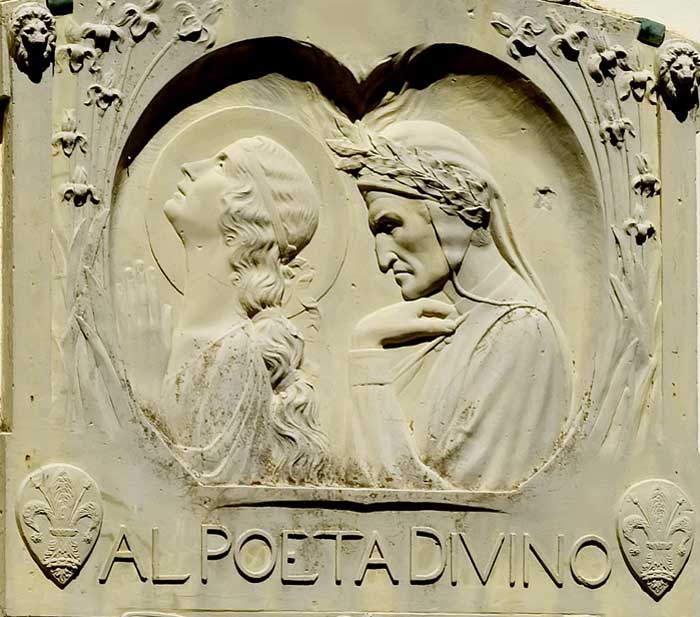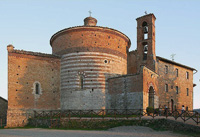Abbey of Vallombrosa | Abbazia di Vallombrosa |
The Benedictine abbey of Vallombrosa is definitely worth a visit. Not only the abbey is a marvellous piece of architecture but it’s also an oase of peace surrounded by beautiful nature. Abbazia di Vallombrosa is a Benedictine abbey in the comune of Reggello in Tuscany, c. 30 km south-east of Florence, in the Apennines, surrounded by forests of beech and firs.
|
|
||
 |
||
A plaque that commemorates a visit from Dante |
||
| The Arboretum of Vallombrosa is a wooded area that is located in Reggello. The arboretum of Vallombrosa, which ranks as Italy's most important collection of plants cultivated for scientific and experimental purposes, currently holds approximately 5,000 specimens, subdivided into over 700 species of trees and shrubs. Founded in 1870 by Adolfo di Berenger, the first director of the Forestry Institute, it stands on silica ground in an area where chestnut trees give way to beech trees. Today's arboretum is divided into seven smaller "arboreta", created in different periods, each named after the curators who have been in charge from the year of its foundation to the present day: Arboreto di Berenger (1870), Arboreto Siemoni (1880), Arboreto Tozzi (1886), Arboreto Perona (1914), Arboreto Gellini (1894), Arboreto Pavari (1923-1958), Arboreto Allegri (1976). Address Vallombrosa Abbey Via San Benedetto, 2
50066 Vallombrosa FI
Address Arboreto di Vallombrosa Via del Paradisino
50066 Vallombrosa FI
www.selvicoltura.org Tel.: 055862008 Opening hours: daily by appointment |
||
|
||||
Located on the outskirts of Castiglioncello Bandini, in a hilly and unspoilt land, Podere Santa Pia is one of the best places to slow traveling in Tuscany. This formal cloister offers the quiet tranquility of a private retreat, with numerous attractions, beautiful nature reserves and unspoilt beautiful beaches within easy reach. The most interesting artistic, historical and cultural sites of southern Tuscany are nearby, and are awaiting your discovery. |
||||
Podere Santa Pia |
Podere Santa Pia, garden |
L'eremo di Montesiepi (the Hermitage of Montesiepi) |
||
|
||||
| Reggello extends from the north-western side of the mountains of the Pratomagno to the higher Valdarno, about 25 km southeast of Florence. The place name comes from the Latin word "rege" with reference to some "Longbard properties". The first settlements in the territory of Reggello go back to the Etruscan and Roman Ages but the real consolidation of the village occurred during the Middle Ages, specifically between the X-th and the XI-th centuries. From the end of the XIII-th century to the beginning of the XIV-th century Reggello was under the jurisdiction of the powerful city of Florence that, taking in account the strategic position of Reggello at the junction of two important roads, the "Via del Casentino" and the "Via Vetus", fortified the village by erecting an imposing ring of walls. The most famous point of interest is the Abbey of Vallombrosa, located in the famous Vallombrosa forest, 10 kilometres (6.2 mi) from the city's downtown. In 1966, 7 people were killed and a neighborhood of Reggello was destroyed by a landslide triggered by the same rains that also flooded Florence. Figline Valdarno rises between the slopes of the Chianti hills and the left bank of the Arno river. The place name comes from a compound name by the Latin word "Figalinae" with the meaning of "potter or argil mine" and the specification of "Valdarno" took in 1863 for the position of the town along the Arno river. The first settlements in the area of Figline Valdarno go back to the Stone Age, as testified by the numerous finds came to light in the area. During the Roman period, the village became an important agricultural centre; however, the real consolidation of the residential settlements in the area of Figline Valdarno started around the XI-th century by building a castle, that belonged to the Uberti's family, and the first parishes. In 1250 the city of Florence invaded the territory of Figline Valdarno and destroyed the castle. Entered the Florentine orbit, Figline Valdarno was fortified in order to face up to the continuous attacks by the Ghibellines against the Florentine Republic and thus in 1356 Florence started the building of an imposing ring of walls and a urban plane consisting of three important roads that connected the town to the cities of Florence, Arezzo and Siena. In the next century, under the Medici's domination, Figline valdarno became the "Florence's barn". Among the most important monument to see rhere, do not miss to visit the Collegiata Church of St. Maria, the Church of St. Francis, the Church of St. Biagio and the Pretorian Palace. The main A1 passes very near Reggello, the nearest exit being Incisa Valdarno. The nearest railway station is Figline Valdarno with a bus connection to Reggello. The same bus service runs between Florence and Reggello. |
||||




